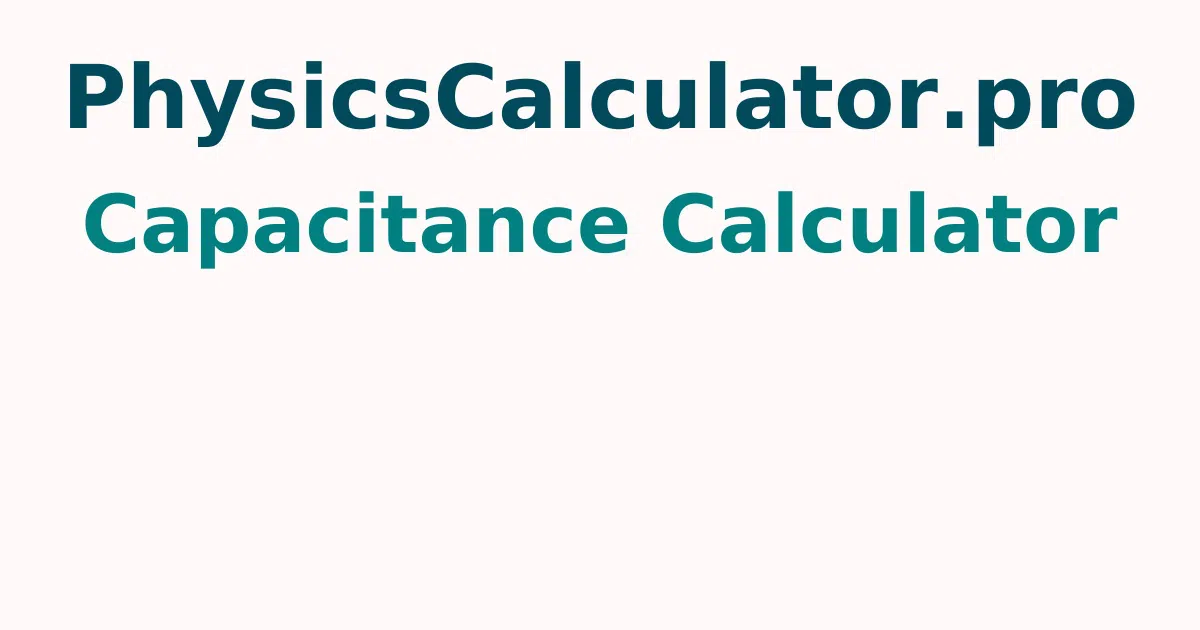Capacitance Calculator
Find Parallel Plate Capacitance in one step with the Capacitance Calculator, which includes a step-by-step description. To determine the unknown parameter in the Capacitance Equation, simply fill in the required input values in the tool's designated fields and press the calculate button.
What is Meant by Capacitance?
The capacitance in an electrical circuit is defined as the ratio of the electric charge to the potential difference in the circuit. Capacitance is a type of capacitor that can store electric energy. Capacitors are extensively utilised to store enormous amounts of energy, even though they store electrical energy. Farads is the SI unit for measuring the capacitance of a capacitor (F).
Capacitance, C = Q/V
- Where, Q = electric charge
- V = difference in potential
Capacitance Equation
The formula C = ε A/s can be used to calculate the capacitance of parallel plates.
- C = capacitance and it is measured in units.
- ε = dielectric permittivity and it is measured in Farads per metre.
- A = area where the Plates are located.
- s = distance between the two plates.
Permittivity is usually determined by the dielectric substance. The Permittivity in a vacuum is 8.854 pF/m
How to Calculate the Capacitance?
To simply determine the Parallel Plate Capacitance, follow the easy techniques described below. They are arranged as follows
- Determine which substance you wish to employ as a dielectric between two plates first.
- The next step is to determine the permittivity of the dielectric substance you've chosen.
- Determine the area of the plates later.
- Put all of the values from the capacitance equation into the formula, then measure the distance between the plates. C = εA/s.
- If you simplify the equation, even more, you can easily calculate the capacitance of parallel plates.
How to use the Capacitance Calculator?
The following is the procedure how to use the capacitance calculator
- Step 1: In the input area, enter the electric charge, potential difference, and x for the unknown value.
- Step 2: To calculate the capacitance value, click the "Calculate the Unknown" option.
- Step 3: Finally, in the output field, the capacitance of the electric field will be displayed.
For more concepts check out physicscalculatorpro.com to get quick answers by using this free tool.
Examples on Capacitance
Question 1: The area of a parallel plate capacitor kept in the air is 2.25 m^2, and the plates are spaced by 0.09 m. Calculate the capacitance of parallel plates.
Solution:
Given:
Area of Plates A = 2.25 m^2
Distance between two plates = 0.09m
Relative Permittivity of Air = 1
The formula for Capacitance C = εA/s
C = 1 x 2.25/0.09 = 25F
Hence, Capacitance acting on Parallel Plates is 25 F.
Question 2: Determine the area of the plates if the capacitance is exactly 1 F and the plate separation is 2.0 x 10^-3 m.
Solution:
Given:
Area of Plates A = ?
Distance between two plates = 2.0 x 10^-3 m
Relative Permittivity of Air = 1
ε = 8.85x10^-12
C = 1F
The formula for Capacitance C = εA/s
1 = (8.85x10-12) A/(2.0x10-3)
A = 2.3x10^8 m²
Hence, the area of the plates is 2.3x10^8 m^2.
FAQs on Capacitance Calculator
1. What is the formula for calculating capacitance?
The formula C=Q/V is used to calculate capacitance by dividing electric charge by voltage. Its unit is Farad.
2. What is the formula for calculating capacitance in series?
Capacitors are said to be in series when they are connected one after the other. The total capacitance of capacitors in series can be calculated by adding up the reciprocals of the individual capacitances and taking the reciprocal of the total.
3. What is the formula for calculating voltage and current capacitance?
Capacitance (C) = charge (Q) / volts (V). A capacitor's size (C) is determined by the ratio of the charge it stores (Q) to the voltage applied across it (V). The farad (F) is the unit of capacitance (C).
4. What is the procedure for changing J to MJ?
Divide the energy by the conversion ratio to convert a joule measurement to a megajoule measurement. The energy in megajoules is calculated by multiplying the joules by 1,000,000.
5. What is the formula for calculating net capacitance?
The equivalent (net) capacitance of capacitors connected in a parallel combination is the average of all individual capacitances in the network, Cp=C1+C2+C3+.....
